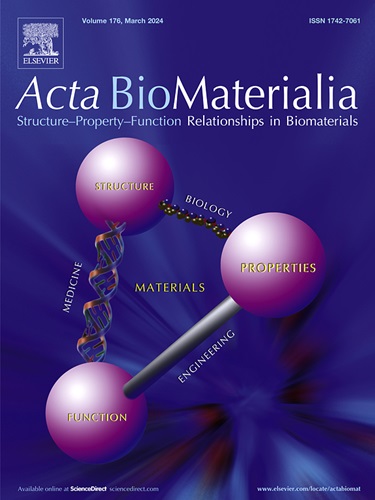Research progress on the performance of expandable systems for long-term gastric retention
IF 9.4
1区 医学
Q1 ENGINEERING, BIOMEDICAL
引用次数: 0
Abstract
Gastroretentive systems have gained attention due to their prolonged retention time in the human body, and they have the potential to improve treatment effects, simplify treatment regimens, and improve patient compliance. Among these systems, expandable gastroretentive systems (EGRSs) have emerged as an important type of carrier that can reside in the stomach for a desired period through on-demand expansion for drug delivery, obesity intervention, and medical diagnosis. As the physiological environment significantly influences the performance of EGRSs, here, the physiological factors such as the stomach's physiological structure and activity pattern, and the character of gastric juice are summarized. Following this, the research progress of EGRSs from ingestion to removal for long-term gastric retention is discussed with respect to the influencing factors and reinforcement strategies in mechanics. Additionally, as the duration of gastric retention increases, safety concerns arise. As such, safety issues in terms of removal after retention or in an emergency are also analyzed. Finally, the biomedical application of EGRSs as diagnostic and therapeutic tools and the potential direction for further research are discussed.
Statement of significance
Expandable gastroretentive systems (EGRSs) resist gastric emptying due to their size exceeding the pylorus diameter, offering promising advantages for obesity intervention, drug delivery, and carrying sensors. However, a long gastroretentive time only by such a size mismatch is hard to be achieved due to the uninterrupted stomach contraction and gastric juice erosion. Recent studies indicate that the retention time and stability of EGRSs can be regulated by adjusting their mechanical properties. Hence, this review summarizes the state-of-art progress of EGRSs for long-term gastric retention from a mechanical perspective for the first time, focuses on material components and synthesis methods, and the reinforcement strategies, and suggests the required mechanical property parameters of EGRSs.

长期胃潴留可扩展系统性能的研究进展。
胃保留系统因其在人体内停留时间较长而受到关注,并且具有改善治疗效果、简化治疗方案和提高患者依从性的潜力。在这些系统中,可扩展胃保留系统(egrs)已经成为一种重要的载体类型,它可以通过按需扩展在胃中停留一段所需的时间,用于药物输送、肥胖干预和医学诊断。由于生理环境对egrs的性能有显著影响,本文就胃的生理结构、活动模式、胃液特性等生理因素进行综述。在此基础上,从力学角度探讨了egrs从摄入到去除长期胃潴留的研究进展,以及影响因素和强化策略。此外,随着胃潴留时间的增加,安全性问题也随之出现。因此,还分析了在保留后移除或紧急情况下的安全问题。最后,讨论了egrs作为诊断和治疗工具在生物医学上的应用以及未来的研究方向。意义声明:可扩展胃保留系统(egrs)由于其大小超过幽门直径而抵抗胃排空,在肥胖干预、药物输送和携带传感器方面具有很好的优势。然而,由于胃不间断收缩和胃液侵蚀,仅靠这种尺寸不匹配难以获得较长的胃保留时间。最近的研究表明,可以通过调节egrs的力学性能来调节其滞留时间和稳定性。因此,本文首次从力学角度综述了用于长期胃潴留的EGRSs的研究进展,重点介绍了EGRSs的材料组成、合成方法、加固策略,并提出了EGRSs所需的力学性能参数。
本文章由计算机程序翻译,如有差异,请以英文原文为准。
求助全文
约1分钟内获得全文
求助全文
来源期刊

Acta Biomaterialia
工程技术-材料科学:生物材料
CiteScore
16.80
自引率
3.10%
发文量
776
审稿时长
30 days
期刊介绍:
Acta Biomaterialia is a monthly peer-reviewed scientific journal published by Elsevier. The journal was established in January 2005. The editor-in-chief is W.R. Wagner (University of Pittsburgh). The journal covers research in biomaterials science, including the interrelationship of biomaterial structure and function from macroscale to nanoscale. Topical coverage includes biomedical and biocompatible materials.
 求助内容:
求助内容: 应助结果提醒方式:
应助结果提醒方式:


